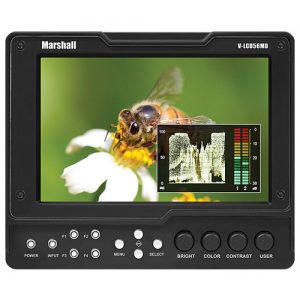Access Privileges: Must have taken Cinematography (FMMC1018) or completed Camera Workshop taught by Ethan and Sinead
Overview:
The Marshall Electronics V-LCD56MD 5.6″ HDMI Monitor is a 1280 x 800 high-resolution camera-top panel, equipped with IPS technology and an adjustable LED backlight, featuring 300 nit brightness, a 500:1 contrast, an icon-driven operating system, and advanced versions of many familiar features, (and a not-so-familiar feature: DSLR Ratio Adjustment).
Connections are on the rear panel and consist of a modular 3G SDI input, an HDMI input and an HDMI output (and a micro USB port). The SDI input gives you 16 channels of de-embedded stereo audio and the HDMI input 8 channels. You can monitor the audio on-screen on a dual-bar Waveform display and with headphones via a stereo headphone output. The front panel has 14 buttons four of which are user configurable with 32 possible uses. For mounting, a 1/4″-20 screw-hole is available on every side of the monitor.
A polycarbonate coating protects the screen from scratches; a power supply comes included; and many different battery adapters are compatible with the monitor so you can work with most of the common batteries out there (please see specs for battery compatibility).
- DSLR Ratio Adjustment
- Lets you scale video that does not completely fill the monitor’s screen when connected by HDMI in “Record” mode on certain Canon DSLRs. You can scale DSLR video output, fill the screen, and eliminate black pillar bars with a variety of options to choose select, from Normal, to 3:2, 16:9, and Full Screen. DSLR Ratio Adjustment is programmable to one of the four user-configurable buttons on the front panel.
- Waveform and Audio
- The LCD56MD incorporates both a Waveform display and Stereo Audio bars. These may be displayed separately or together in any one of the four corners of the monitor. The Stereo Audio is de-embedded from either the input.
- Zebra Clip Guide
- The Zebra function visually filters parts of images under a Lower Threshold or over an Upper Threshold. Data on either side of the filters can be displayed with a custom color. Zebra can also be inverted to filter the area between the Upper and Lower Threshold. The color selected for the Lower Threshold acts as the color for all inverted Zebra data.
- Input Crop with Auto Scaling
- The Input Crop function selects the area of active video that you would like shown on the image display. Select the desired Input by accessing the Adjust option on the screen.
- Custom Pixel-to-Pixel Panning
- Lets you select a custom Pixel-to-Pixel zone and use the COLOR knob to move your selection LEFT and RIGHT and the CONTRAST knob to move UP or DOWN. The SELECT button locks in your selection.
- False Color
- Helps set camera exposure. As the camera Iris is adjusted, elements of the image will change color based on the luminance or brightness values.
- Peaking
- Helps get the sharpest possible picture. When activated, the internal processor will display a colored highlight on the screen where sharp edges appear. When the camera operator adjusts (“racks”) the focus control / camera lens, different parts of the image will have these colored highlights. This indicates that this portion of the image is sharp or in focus. Final focus is achieved by racking the camera lens focus control back and forth until the desired portion of the image has the colored highlights.
- Adjustable Screen Markers
- A variety of screen markers in 4:3, 16:9, and full screen modes allow accurate monitoring of the different aspect ratios used in broadcast environments. User Markers allow for custom aspect ratio, cropping framing, now with a choice of four colors and variable width lines.
- 6 Custom Configuration Presets
- Six User Setting Presets allow the user to save six system configuration files for later recall when needed. These configuration files will save 38 different parameters that can be adjusted by the user.
- User-Definable Function Buttons
- Four user-definable function buttons on the front-panel allow quick access to numerous settings and features including focus-assist, false color filter, aspect ratio, screen markers, monochrome mode, color temperature, delay mode, and more.
- Stereo Headphone Output
- You can monitor 16 channels of audio from the 3G SDI input
